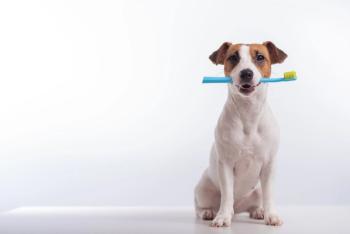
The Educated Client: Urinary Incontinence - More Than an Inconvenience
For pet owners whose cat or dog suffers from the condition, understanding and treating urinary incontinence is anything but simple.
Urinary incontinence is defined simply as the involuntary passing of urine. But for pet owners whose cat or dog suffers from the condition, understanding and treating urinary incontinence is anything but simple.
The most common indicator that an animal might be suffering from incontinence is urination inside the home or outside the litter box that is persistent and seemingly unrelated to a behavioral issue. In most instances, incontinent pets may not even recognize that they’re urinating.
A pet owner might notice small or large puddles of urine when the animal is standing, sitting, or even sleeping. Pets with urinary incontinence may also have wet hindquarters and irritated skin and smell of urine.
It’s important for pet owners to obtain a diagnosis from a veterinarian because incontinence can easily be confused with frequent urination, but the 2 are very different. Your veterinarian will also want to rule out behavioral disorders. In these instances, a pet would likely urinate because of a particular event, such as a loud noise, and not a true medical condition. Similarly, urinary incontinence should not be confused with submissive urination, which occurs when a pet (usually a dog) is acting submissively to a person or other animal. In instances like these, if behavior is believed to be the cause, your veterinarian can still provide some techniques to reverse the action or refer you to a veterinary behaviorist for further treatment.
Causes
There are many reasons why an animal may be incontinent, including problems involving the bladder or urethra. Incontinence can also be caused by birth defects, abnormalities, and injuries in the areas of the spinal cord and brain that control bladder function. Most commonly, urinary incontinence is caused by urethral sphincter incompetence. This is seen most frequently in large-breed, spayed female dogs but may be present in intact females, male dogs, and cats.
Other known causes of urinary incontinence could be related to bladder stones, excessive thirst, a urinary tract infection, and ectopic ureter, a condition characterized by urine that is supposed to be carried to the bladder but ends up somewhere else in the body. Many times, incontinence may be linked to a pet’s age and could be the result of weakened bladder muscles or arthritic issues that prevent the pet from fully expressing its bladder.
Because of the wide range of possible underlying issues, a visit to your veterinarian is a must.
Diagnosis
The tests your veterinarian chooses to evaluate incontinence will likely depend on the cat’s or dog’s age and the presence of other symptoms. Be prepared for your veterinarian to ask for information regarding:
- Age when incontinence first started
- Frequency of urination
- How much water the pet drinks
- Medications the pet is taking
- Presence of blood in the urine
- Previous illness and surgeries
- Signs of discomfort when the pet urinates
- When incontinence is typically observed
In addition to asking these questions and performing a physical examination, your veterinarian may also conduct blood tests to uncover kidney or liver damage that could be leading to increased urine production as well as x-rays or an ultrasound to better observe aspects of the urinary tract.
Treatment
Depending on the cause, there are various methods for treating urinary incontinence. In some cases, surgery may be required, such as when an ectopic ureter is discovered or if a spinal cord injury exists. If an infection is present, then antibiotics will be prescribed to eliminate the bacteria causing the illness. Likewise, diseases such as diabetes will be treated with medications that stabilize the dis- ease and curb incontinence.
In other instances, medications may be prescribed to strengthen the muscles that hold urine in the bladder. Some drugs commonly used for this purpose include estrogen, ephedrine, and phenylpropanolamine. In male dogs, testosterone injections are also used to treat urinary incontinence but are generally less effective than estrogen therapy in female dogs.
For some pets, treatment may not reverse the problem entirely. If urinary incontinence persists, your veterinarian can review various environmental and lifestyle modifications that will help keep your pet happy and clean despite frequent, involuntary urination. These include purchasing beds that can be easily and regularly washed or replaced as they become soiled, having your cat or dog wear a diaper or a bellyband to prevent leakage, and cleaning the area around the abdomen and legs so it doesn’t become irritated or infected because of lingering urine.
Your veterinarian understands that urinary incontinence is much more than an inconvenience and will work with you and your pet to nd the best course of action to reestablish a healthy lifestyle.
Newsletter
From exam room tips to practice management insights, get trusted veterinary news delivered straight to your inbox—subscribe to dvm360.




